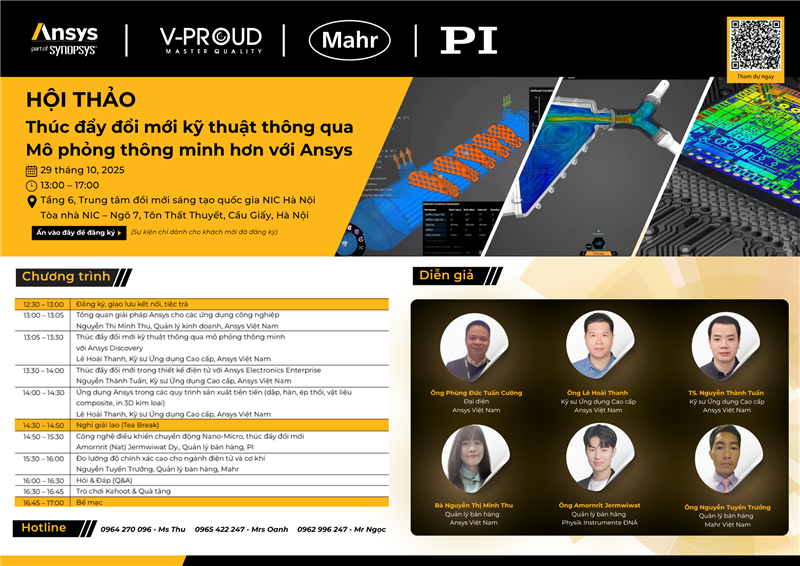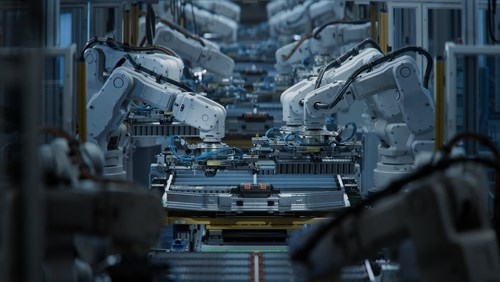
SCANOLOGY has just introduced NimbleTrack Gen2. With upgraded technology, SCANOLOGY's NimbleTrack Gen2 is capable of scanning large and complex areas significantly faster, while maintaining measurement-level accuracy. This is the next generation of the company's mobile optical tracking and 3D scanning systems. SCANOLOGY's NimbleTrack Gen2 is designed to deliver higher performance, especially in speed and measurement range.

A breakthrough opportunity for R&D processes awaits the Vietnamese engineering community. The specialized workshop "Driving Engineering Innovation Through Smart Simulation" organized by ANSYS will take place on October 29, 2025, at the Innovation Hub Building, updating the latest advanced simulation solutions for the manufacturing, electronics design, and Nano-Micro industries.

In the global race to automate manufacturing, China is emerging as a pioneer with the “dark factory” model – where robots and artificial intelligence completely replace humans. Requiring no light or rest, the new generation of factories operate continuously 24/7 with superior precision and efficiency.
Even with a limited component supply, laser trackers can help you make the most of the supplies and labor that you do have.
As the pandemic recedes, lingering supply chain issues remain. “About the only thing certain right now is the challenges to global supply chains are going to increase for the foreseeable future,” as David Simchi-Levi and Pierre Haren write in Harvard Business Review.
This means companies may face lead times of 52 weeks for a particular component.
Picture the scene: Your long-awaited components have finally arrived. It's time to begin production. Now, imagine that your yield rates are 95%. In other words, of a production run of 1,000 parts, 50 have to be reworked or scrapped. In this scenario—when parts have already been delayed—you would particularly want your yield to be 100%.
![]()
In industries as varied as automotive and aerospace, supply chain challenges are a top issue. Whether you are trying to build a new product or redesign an existing one, having the right tools can help. Laser trackers are one way to address these issues.
When you think of supply chain challenges, there are many factors at play. A shortage may include supplies as well as personnel. Companies may lack critical components, as the quantity of supplies coming into the facility have dipped, but they also may find it difficult to staff their facility at traditional levels.
While metrology isn't going to go back in and put more personnel in the facility, it can help with some of these challenges.
Even with a limited component supply, laser trackers can help you make the most of the supplies and labor that you do have. The main benefit of laser tracker technology is the ability to measure large and complex parts in less time during the manufacturing process so that you can catch defects early and increase yield.
When supply is limited, you must avoid scrap at all costs. With a scarce supply, manufacturers want to be careful to build products properly. Making something right the first time becomes urgent.
Portable metrology such as laser trackers step in to fill this need. For example, with a CNC mill, the laser tracker can be used to compensate the equipment. Thus, the quality you get out of it is higher, the yield is higher, and you scrap fewer parts. In addition to calibration of equipment, laser trackers would offer in-process verification.
![]()
For the CNC mill, with a block of material in a machining operation, many of those operations can be multi-hour processes. The last thing you want is to come back in eight hours and find that the end result is not right. This would lead to another long machining session or time spent figuring out what went wrong. In this case, your limited supply of parts is not getting you to where you need to be. You may fall behind on delivery times, or fail to meet a customer's requirements.
On the other hand, by using a laser tracker, after only one or two hours into the process you would be able to find defects.
The laser tracker can also help you set up a part properly. When you're doing less rework and making products right the first time, you are able to better utilize your resources. If you only have eight hours in the day, you don't want to spend six hours reworking parts.
Some companies may find that switching from a CMM to portable metrology also lessens rework. While CMMs are accurate, in some situations, manufacturers may find quality issues with a production run only after the process is complete. For example, one manufacturer of large presses found that its rework process time was reduced once they switched to laser trackers.
As further proof of their usefulness, the demand for laser trackers remained consistent during the pandemic, and their levels of production remained consistent. This is rare for the metrology industry, and makes it clear that laser trackers fit a need that no other product can. While budgets may have been tighter, manufacturers found that they needed a laser tracker to maintain the necessary levels of production.
![]()
In fact, the pandemic may have changed the way manufacturers used laser trackers. Some companies that used a service provider for their laser tracker needs during the pandemic discovered supply chain weaknesses, making apparent that this type of capability should not be something you only outsource. If you don't have the in-house capability, you are at the whims of other companies.
To get the most benefit out of this portable metrology equipment, it's important that you have a quality laser tracker device. In order to measure complex parts in less time with the best yield, inspection speed is critical.
Beyond supply chain issues, many manufacturers are also challenged with a shortage of trained metrologists. While manufacturers may be familiar with the laser trackers of 10 years ago, which were likely more difficult to use, today's trackers require far less training that even a novice can learn. With the right laser tracker and software package, manufacturers are able to train their current staff to use a laser tracker and get the high-quality data they need over the course of a single day. Many companies have found, to their surprise, that today's laser trackers can produce high-quality data with their current personnel.
In addition, more manufacturers are opting for laser trackers that can also measure beyond the laser tracker line of sight. This is possible by using a 6 Degree of Freedom (6DoF) probe. The 6DoF probe allows you to inspect more parts in less time, and at more phases of your manufacturing process. Although these tools are more expensive, more and more customers are seeing the value. Once again, when labor time is short, investing in inspection solutions pays dividends.
While some of the supply chain issues of the early pandemic have lessened, no one is counting on an immediate return to normal. To be successful you need to hope for the best and plan for the worst. With better inspection solutions and data, manufacturers can optimize their processes and minimize the disruption. If you are relying on laser trackers, supply chain challenges don't have to slow you down.
Source: Faro
Read Quality Mastery magazine to get more information about quality management: https://qualitymastery.v-proud.vn/
If you are looking for quality management solutions, visit the following websites: v-proud.vn/product and doluongcongnghiep.vn.
#lasertracker #faro #supplychain #chuoicungung #industry #covid #CNC #CMM #metrology #doluong
(84) 896 555 247